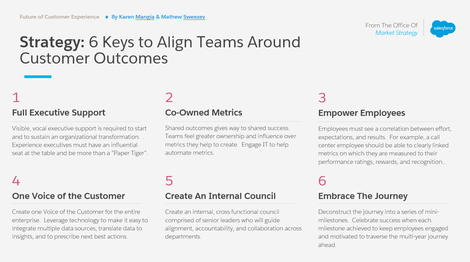In the next normal, businesses must develop a new customer engagement model that places a strong emphasis on measuring progress based on outcomes.
COVID-19 pandemic has significantly accelerated digital business transformation. The pandemic led to breakneck speed shift to digital-first customer engagement and remote work, prompting service and support organizations to reconsider the future of their people, process, and technology. According to recent research from Salesforce, teams are navigate new standards of engagement. As customer expectations shift, a new digital-first playbook is emerging. Eighty-one percent of decision makers say they’re accelerating digital initiatives.
As the pandemic panic gives way to post-pandemic planning, how well-positioned is your organization to deliver growth? A series of intimate conversations with Customer Experience and Customer Success executives reveals a new playbook for growth in the next normal and beyond.
Research shows that in order for businesses to connect with their customers, they must focus on outcomes, a new set of customer health metrics, improved service agility and opportunities to co-create value.
The new customer experience playbook is here: https://t.co/NKP28MQzB2 pic.twitter.com/8N00xDygSs
— Vala Afshar (@ValaAfshar) December 22, 2020
Here are eight strategic questions your organization can ask right now to look in the direction of growth, inspired by groundbreaking new research from Karen Mangia and Mathew Sweezey of Salesforce:
The first four plays with a question prompt to consider are:
Instead of trying to be all things to all people, who can you serve best? Go narrow and deep. Who is your customer now? Invest in new buyers and influencers.
How many Voice of the Customer (VOC) repositories does your organization maintain? Simplify and centralize customer insights.
Which more strongly correlates with results for your organization: Customer Outcomes or Customer Experiences? Redefine Customer Success.
Once you create alignment with your key stakeholders about the answers to these questions, the next four plays with a question prompt to consider are:
Which organizational silos could you break down using customer outcomes as a catalyst? Correlate Customer Experiences with Customer Outcomes.What is the best measure of your customer relationship health? As you evolve your definition of who your customer is and how you define customer success, evolve your metrics as well. This may mean a shift away from Net Promoter Score (NPS) toward Time To Value (TTV).How can you move at the speed of customer relevance? Innovating a new future requires organizational agility. What’s one process step you can remove to enable your customer facing teams to become more agile?
Are you co-creating with your customers? What would it mean to your organization if you could collaborate with your customers to design the outcomes you aspire to achieve together?
What is the customer experience of the future?
Delivering the customer experience of the future begins with leveraging the current shift in customer expectations and operating context as an opportunity to reset priorities and develop a new CX playbook. https://t.co/u12dtrBhtN pic.twitter.com/tTd8zywxjQ
— Vala Afshar (@ValaAfshar) December 9, 2020
Once you set your strategic direction, consider the organizational structure that sets you up for success. Experience Executives reveal that organizational hierarchies of the past are no longer effective to deliver the outcomes of the future. While the executives represented organizations of varying sizes and industries, four common core principles influenced their structural redesigns beyond what we’ve detailed above:
The most effective employee loyalty program ever launched is leadership trust.
— Karen Mangia (@karenmangia) November 18, 2020
Executive Support is the mission-critical first step. Visible, vocal executive support is required to launch the transformation and to sustain the transformation. Leaders responsible for delivering new results in new ways must go beyond having a seat at the table to have decision making influence and authority. Access to budget – particularly for change management, reskilling and retooling – is also critical. Resource investment signals this portfolio is a priority.
Correlate employee effort with employee success. Create a clear between employee effort, employee results, and employee rewards and recognition. Do your employees see themselves in your mission as well as your metrics? Ask your employees for feedback to confirm or deny your hypothesis.
Create a ‘customer outcomes’ council. Create an internal council to help drive these changes across the organization. The council should be constructed of senior leaders from various departments and broken into working groups focused on the key experiences and moments of truth along the customer journey.
Create and celebrate mini-milestones. Break your long-term journey down into a series of mini-milestones and micro-moments. Make sure to measure what matters to your customers and their definition of successful outcomes. Share the results and progress made. Celebrate progress. Celebrate behavior change. Celebrate new results.


Strategy: 6 Keys to Align Teams Around Customer Outcomes
Businesses must continue to measure effort and progress and the journey towards earning your customer’s future business starts with measuring and reporting outcomes to all stakeholders. Cultivating a culture of responsibility and accountability starts with trust and radical transparency. Growing companies measure their progress based on their customer’s ability to achieve their desired business goals. The two most important core values of successful companies will be trust and customer success. In the next normal, business leaders must adopt an outside-in approach of ensuring that they are consistently able to deliver outcomes that matters to their customers, partners, and communities.
Discover additional insights, strategies and actions you can take using the slide deck here.
What are you discovering about how to transform your customers’ experience? We invite you to join us on Twitter @valaafshar, @karenmangia and @msweezey.
This article was co-authored by Karen Mangia, vice president, Customer and Market Insights, at Salesforce and Mathew Sweezey, director of Market Strategy, at Salesforce.
Karen Mangia is vice president, Customer and Market Insights at Salesforce. Her work focuses on strategies for personal and professional success, and she regularly works with executives, managers, and future leaders at companies of all sizes globally. She launched two new books in 2020: Listen Up! How to Tune In To Customers, And Turn Down the Noise and Working From Home: Making the New Normal Work For You – both from Wiley. She has been featured in Forbes and regularly writes for Thrive Global and ZDNet. Committed to diversity and inclusion, she serves on her company’s Racial Equality and Justice Task Force. She is a TEDx speaker and the author of Success With Less, a book that chronicles her own personal journey through a life-threatening health crisis. Her high-impact keynotes help organizations to access the future of work via innovative insights around the voice of the customer.
Mathew Sweezey is Director of Market Strategy at Salesforce. His work focuses on the future of marketing, and what brands must do to stay relevant with consumers amidst the continuously shifting landscape. His latest book The Context Marketing Revolution was published by Harvard Business Press in 2020 and has become an Amazon Best Seller. His work is often featured in leading publications such as The Economist, Forbes, AdAge, The Observer, and Brand Quarterly.



